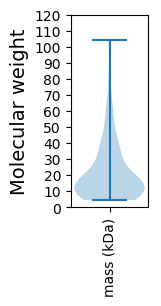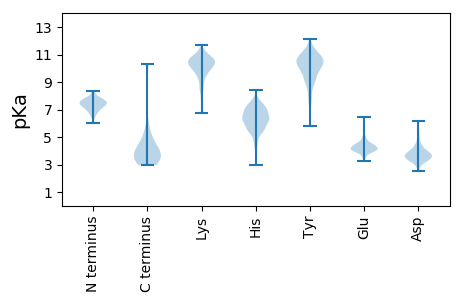
Mycobacterium phage SpongeBob
Taxonomy: Viruses; Duplodnaviria; Heunggongvirae; Uroviricota; Caudoviricetes; Caudovirales; Siphoviridae; Nclasvirinae; Charlievirus; unclassified Charlievirus
Average proteome isoelectric point is 5.97
Get precalculated fractions of proteins

Virtual 2D-PAGE plot for 65 proteins (isoelectric point calculated using IPC2_protein)
Get csv file with sequences according to given criteria:
* You can choose from 21 different methods for calculating isoelectric point
Summary statistics related to proteome-wise predictions



Protein with the lowest isoelectric point:
>tr|A0A481VVU5|A0A481VVU5_9CAUD Excise OS=Mycobacterium phage SpongeBob OX=2530151 GN=35 PE=4 SV=1
MM1 pKa = 6.56TTPMTLNLDD10 pKa = 3.26QPMFVPCGTQVITTQPLVVEE30 pKa = 4.5LADD33 pKa = 3.63YY34 pKa = 10.68DD35 pKa = 4.04YY36 pKa = 11.58TPFADD41 pKa = 4.08PLAPAFDD48 pKa = 4.38FLADD52 pKa = 3.9RR53 pKa = 11.84LHH55 pKa = 7.5PDD57 pKa = 2.94GTLDD61 pKa = 4.12RR62 pKa = 11.84DD63 pKa = 4.36VPCTSLPGRR72 pKa = 11.84STIEE76 pKa = 4.24RR77 pKa = 11.84ITT79 pKa = 3.33
MM1 pKa = 6.56TTPMTLNLDD10 pKa = 3.26QPMFVPCGTQVITTQPLVVEE30 pKa = 4.5LADD33 pKa = 3.63YY34 pKa = 10.68DD35 pKa = 4.04YY36 pKa = 11.58TPFADD41 pKa = 4.08PLAPAFDD48 pKa = 4.38FLADD52 pKa = 3.9RR53 pKa = 11.84LHH55 pKa = 7.5PDD57 pKa = 2.94GTLDD61 pKa = 4.12RR62 pKa = 11.84DD63 pKa = 4.36VPCTSLPGRR72 pKa = 11.84STIEE76 pKa = 4.24RR77 pKa = 11.84ITT79 pKa = 3.33
Molecular weight: 8.72 kDa
Isoelectric point according different methods:
Protein with the highest isoelectric point:
>tr|A0A481VWG9|A0A481VWG9_9CAUD Minor tail protein OS=Mycobacterium phage SpongeBob OX=2530151 GN=18 PE=4 SV=1
MM1 pKa = 7.28HH2 pKa = 7.5VIPANFGGPMRR13 pKa = 11.84RR14 pKa = 11.84EE15 pKa = 4.24CAVCGQPFEE24 pKa = 4.28AQRR27 pKa = 11.84PQAKK31 pKa = 9.99YY32 pKa = 10.5CGEE35 pKa = 4.18TCRR38 pKa = 11.84KK39 pKa = 8.35RR40 pKa = 11.84AQRR43 pKa = 11.84GGIAKK48 pKa = 9.84QKK50 pKa = 8.75QQQTAPAPAASAAPSGGGLIEE71 pKa = 4.24TVQAALEE78 pKa = 4.07QADD81 pKa = 4.59RR82 pKa = 11.84LNTIAGQHH90 pKa = 5.55ALEE93 pKa = 4.05LARR96 pKa = 11.84RR97 pKa = 11.84IVYY100 pKa = 10.17APGMNTGVAALSKK113 pKa = 10.36QLQAVLAEE121 pKa = 4.45ALAGTAPVAADD132 pKa = 3.61PVDD135 pKa = 3.63EE136 pKa = 4.52LKK138 pKa = 10.88ARR140 pKa = 11.84RR141 pKa = 11.84DD142 pKa = 3.29AKK144 pKa = 10.34RR145 pKa = 11.84RR146 pKa = 11.84RR147 pKa = 11.84GAA149 pKa = 3.22
MM1 pKa = 7.28HH2 pKa = 7.5VIPANFGGPMRR13 pKa = 11.84RR14 pKa = 11.84EE15 pKa = 4.24CAVCGQPFEE24 pKa = 4.28AQRR27 pKa = 11.84PQAKK31 pKa = 9.99YY32 pKa = 10.5CGEE35 pKa = 4.18TCRR38 pKa = 11.84KK39 pKa = 8.35RR40 pKa = 11.84AQRR43 pKa = 11.84GGIAKK48 pKa = 9.84QKK50 pKa = 8.75QQQTAPAPAASAAPSGGGLIEE71 pKa = 4.24TVQAALEE78 pKa = 4.07QADD81 pKa = 4.59RR82 pKa = 11.84LNTIAGQHH90 pKa = 5.55ALEE93 pKa = 4.05LARR96 pKa = 11.84RR97 pKa = 11.84IVYY100 pKa = 10.17APGMNTGVAALSKK113 pKa = 10.36QLQAVLAEE121 pKa = 4.45ALAGTAPVAADD132 pKa = 3.61PVDD135 pKa = 3.63EE136 pKa = 4.52LKK138 pKa = 10.88ARR140 pKa = 11.84RR141 pKa = 11.84DD142 pKa = 3.29AKK144 pKa = 10.34RR145 pKa = 11.84RR146 pKa = 11.84RR147 pKa = 11.84GAA149 pKa = 3.22
Molecular weight: 15.64 kDa
Isoelectric point according different methods:
Peptides (in silico digests for buttom-up proteomics)
Below you can find in silico digests of the whole proteome with Trypsin, Chymotrypsin, Trypsin+LysC, LysN, ArgC proteases suitable for different mass spec machines.| Try ESI |
 |
|---|
| ChTry ESI |
 |
|---|
| ArgC ESI |
 |
|---|
| LysN ESI |
 |
|---|
| TryLysC ESI |
 |
|---|
| Try MALDI |
 |
|---|
| ChTry MALDI |
 |
|---|
| ArgC MALDI |
 |
|---|
| LysN MALDI |
 |
|---|
| TryLysC MALDI |
 |
|---|
| Try LTQ |
 |
|---|
| ChTry LTQ |
 |
|---|
| ArgC LTQ |
 |
|---|
| LysN LTQ |
 |
|---|
| TryLysC LTQ |
 |
|---|
| Try MSlow |
 |
|---|
| ChTry MSlow |
 |
|---|
| ArgC MSlow |
 |
|---|
| LysN MSlow |
 |
|---|
| TryLysC MSlow |
 |
|---|
| Try MShigh |
 |
|---|
| ChTry MShigh |
 |
|---|
| ArgC MShigh |
 |
|---|
| LysN MShigh |
 |
|---|
| TryLysC MShigh |
 |
|---|
General Statistics
Number of major isoforms |
Number of additional isoforms |
Number of all proteins |
Number of amino acids |
Min. Seq. Length |
Max. Seq. Length |
Avg. Seq. Length |
Avg. Mol. Weight |
|---|---|---|---|---|---|---|---|
0 |
13372 |
38 |
1033 |
205.7 |
22.29 |
Amino acid frequency
Ala |
Cys |
Asp |
Glu |
Phe |
Gly |
His |
Ile |
Lys |
Leu |
|---|---|---|---|---|---|---|---|---|---|
12.287 ± 0.71 | 1.144 ± 0.205 |
6.671 ± 0.26 | 5.923 ± 0.302 |
2.902 ± 0.18 | 8.712 ± 0.54 |
1.952 ± 0.162 | 4.554 ± 0.179 |
3.006 ± 0.209 | 7.8 ± 0.236 |
Met |
Asn |
Gln |
Pro |
Arg |
Ser |
Thr |
Val |
Trp |
Tyr |
|---|---|---|---|---|---|---|---|---|---|
1.989 ± 0.162 | 3.059 ± 0.212 |
5.968 ± 0.23 | 3.769 ± 0.243 |
6.858 ± 0.481 | 5.078 ± 0.195 |
6.73 ± 0.263 | 7.389 ± 0.337 |
1.877 ± 0.175 | 2.333 ± 0.178 |
Most of the basic statistics you can see at this page can be downloaded from this CSV file
Proteome-pI is available under Creative Commons Attribution-NoDerivs license, for more details see here
| Reference: Kozlowski LP. Proteome-pI 2.0: Proteome Isoelectric Point Database Update. Nucleic Acids Res. 2021, doi: 10.1093/nar/gkab944 | Contact: Lukasz P. Kozlowski |
